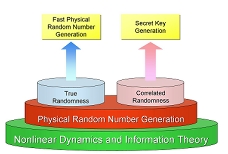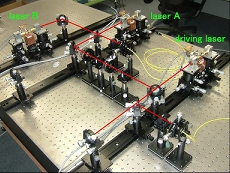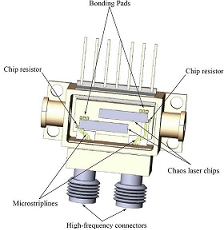
|
|
|
 |
 |
 |
Dynamical Information Processing |
 |
Methods for Communication using Strongly Fluctuating Phenomena |
The use of strong fluctuations in devices poses new possibilities of communication technology. We are exploring the possibilities by applying new methods from the fields of nonlinear dynamics and information theory to problems of signal transmission and generation in strongly fluctuating devices. In particular, we are developing a secure key sharing scheme and a fast and compact physical random number generator, based on strongly fluctuating phenomena in optical devices.
|
[ Reference ] |
* Future Perspective |
[1] J. Muramatsu, K. Yoshimura, K. Arai, and P. Davis, hSecret key capacity for optimally correlated sources under sampling attack,hIEEE Trans. on Information Theory 52 (2006) pp. 5140-5155. |
[2] J. Muramatsu, K. Yoshimura, and P. Davis, hInformation Theoretic Security Based on Bounded Observability,h Lecture Notes in Computer Science 5973 (2010) pp. 128-139. |
[3] T. Yamamoto, I. Oowada, H. Yip, A. Uchida, S. Yoshimori, K. Yoshimura, J. Muramatsu, S. Goto, and P. Davis, hCommon-noise-induced synchronization in semiconductor lasers,h Optics Express 15 (2007) pp. 3974-3980. |
[4] I. Oowada, H. Ariizumi, M. Li, S. Yoshimori, A. Uchida, K. Yoshimura, and P. Davis, hSynchronization by injection of common chaotic signal in semiconductor lasers with optical feedback,h Optics Express 17 (2009) pp. 10025-10034. |
[5] S. Goto, P. Davis, K. Yoshimura, and A. Uchida, hSynchronization of chaotic semiconductor lasers by optical injection with random phase modulation,h Optical and Quantum Electronics 41 (2009) pp. 137-149. |
[6] K. Yoshimura and K. Arai, hPhase reduction of stochastic limit cycle oscillators,h Phys. Rev. Lett. 101 (2008) 154101. |
[7] K. Yoshimura, P. Davis, and A. Uchida, hNonresonant entrainment of detuned oscillators induced by common external noise,h Progress of Theoretical Physics 120 (2008) pp. 621-633. |
[8] K. Yoshimura, J. Muramatsu, and P. Davis,
hConditions for common-noise-induced synchronization in time-delay systems,h Physica D 237 (2008) pp. 3146-3152.
|
* Secure Keys from Correlated Randomness |
[1] A. Uchida, K. Amano, M. Inoue, K. Hirano, S. Naito, H. Someya,I. Oowada, T. Kurashige, M. Shiki, S. Yoshimori, K. Yoshimura, and P. Davis, hFast physical random bit generation with chaotic semiconductor lasers,hNature Photonics 2 (2008) pp. 728-732. |
[2] T. Honjo, A. Uchida, K. Amano, K. Hirano, H. Someya, H. Okumura,K. Yoshimura, P. Davis, and Y. Tokura, hDifferential-phase-shift quantum key distribution experiment using fast physical random bit generator with chaotic semiconductor lasers,h Optics Express 17 (2009) pp. 9053-9061. |
[3] T. Harayama, S. Sunada, K. Yoshimura, P. Davis, K. Tsuzuki, and A.Uchida, hFast nondeterministic random-bit generator using on-chip chaos lasers,h Physical Review A 83 (2011) 031803. |
[4] S. Sunada, T. Harayama, K. Arai, K. Yoshimura, P. Davis, K. Tsuzuki, and A. Uchida, hChaos laser chips with delayed optical feedback using a passive ring waveguide,h Optics Express 19 (2011) pp. 5713-5724. |
[5] S. Sunada, T. Harayama, K. Arai, K. Yoshimura, P. Davis, K. Tsuzuki, and A. Uchida, hRandom optical pulse generation with bistable semiconductor ring lasers,h Optics Express 19 (2011) pp. 7439-7450. |
 |
 |
 |
 |
Copyright (C) NTT Communication Science Laboratories |


